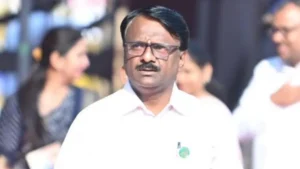The political landscape of Maharashtra is witnessing unprecedented turbulence as the Shiv Sena UBT reorganisation creates ripples across the state’s power corridors. Recent developments suggest a significant shift within Uddhav Thackeray’s faction, with MLA Pravin Swami’s growing proximity to Pratap Sarnaik becoming the focal point of intense speculation about internal dissent and the mysterious “Operation Tiger.”
The growing closeness between Swami and Sarnaik has not gone unnoticed by party observers and political analysts. Their collaboration appears to be part of a broader Shiv Sena UBT reorganisation strategy that could potentially reshape the power structure within the party. This alliance has raised questions about whether it represents a natural evolution of party politics or signals deeper fractures within the organisation.
 The enigmatic “Operation Tiger” has become synonymous with potential factional realignment within Maharashtra’s political spectrum. This operation, which has been the subject of intense speculation, appears to be directly connected to the ongoing Shiv Sena UBT reorganisation. Political insiders suggest that Operation Tiger could be a comprehensive strategy aimed at consolidating power and influence within the party structure.
The enigmatic “Operation Tiger” has become synonymous with potential factional realignment within Maharashtra’s political spectrum. This operation, which has been the subject of intense speculation, appears to be directly connected to the ongoing Shiv Sena UBT reorganisation. Political insiders suggest that Operation Tiger could be a comprehensive strategy aimed at consolidating power and influence within the party structure.
The timing of Operation Tiger coincides with significant changes in the party’s organisational hierarchy, making it a crucial element in understanding the current Shiv Sena UBT reorganisation. The operation’s implications extend beyond mere administrative changes, potentially affecting the party’s electoral prospects and alliance dynamics in Maharashtra’s complex political landscape.
MLA Pravin Swami’s role in the current Shiv Sena UBT reorganisation cannot be understated. His growing influence within the party ranks has positioned him as a key player in the unfolding political drama. Swami’s strategic decisions and alliances are being closely monitored by party leadership and opposition alike, as they could significantly impact the party’s future direction.


Pratap Sarnaik’s emergence as a central figure in the Shiv Sena UBT reorganisation reflects his expanding influence within the party structure. Known for his organisational skills and political acumen, Sarnaik’s involvement in current developments has added another dimension to the ongoing changes within the party.
The relationship between Sarnaik and Pravin Swami has become a focal point for understanding the Shiv Sena UBT reorganisation. Their collaboration appears to be based on shared political objectives and mutual understanding of the party’s future needs. This partnership could potentially serve as a model for other alliances within the reorganised party structure.
The ongoing Shiv Sena UBT reorganisation presents significant challenges for Uddhav Thackeray’s leadership. As the party undergoes structural changes, Thackeray must navigate competing interests while maintaining party unity. The speculation surrounding Operation Tiger and internal alliances adds complexity to his leadership responsibilities.
Thackeray’s response to the Shiv Sena UBT reorganisation will likely determine the party’s ability to maintain its political relevance in Maharashtra. His handling of internal dynamics, particularly the Swami-Sarnaik alliance, could set the tone for future party operations and electoral strategies.
To understand more about Shiv Sena UBT reorganisation
You can also read about Uddhav Thackeray
The Shiv Sena UBT reorganisation has broader implications for Maharashtra’s political landscape. The changes within the party could affect alliance dynamics, electoral calculations, and power distribution across the state. Political observers are closely monitoring these developments to assess their potential impact on future elections and governance.
The reorganisation process also reflects the evolving nature of regional politics in Maharashtra. As parties adapt to changing voter expectations and political realities, the Shiv Sena UBT reorganisation serves as a case study in political transformation and adaptation.
The success of the Shiv Sena UBT reorganisation will largely depend on the party’s ability to balance internal interests while maintaining its core ideological principles. The involvement of key figures like Pravin Swami and Pratap Sarnaik suggests that the reorganisation process is being approached systematically and strategically.
As the Shiv Sena UBT reorganisation continues to unfold, its impact on Maharashtra’s political equilibrium remains to be seen. The party’s ability to emerge stronger from this transformative period will determine its future role in state and national politics.
The ongoing developments within the party structure, including Operation Tiger and various factional realignments, represent a critical phase in the Shiv Sena UBT reorganisation. The outcomes of these changes will likely influence Maharashtra’s political discourse for years to come, making this period particularly significant in the state’s political history.

